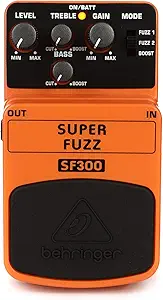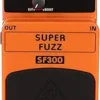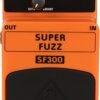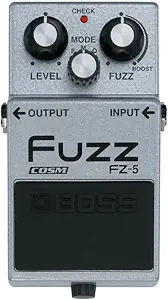Behringer Super Fuzz SF300 review uncovering its 3-mode distortion pedal performance
Behringer Super Fuzz SF300 review uncovering its 3-mode distortion pedal performance
- Produces a rich, vintage fuzz tone that feels authentic and powerful.
- Offers a versatile range of sounds with its three distinct modes, catering to different musical styles.
- The compact and sturdy design ensures durability, even with frequent use.
- Simple control layout makes it easy to shape tones quickly and effectively.
- Excellent value for its price, delivering quality comparable to higher-end pedals.
As an Amazon Associate I earn from qualifying purchases.
Description
My Experience with the BEHRINGER SUPER FUZZ SF300
The Behringer Super Fuzz SF300 is a pedal that promises to deliver a blast from the past, recreating the iconic fuzz tones of the ‘60s and ‘70s. Having tested it extensively, I can confidently say this little box packs a punch, but it’s not without its quirks. From its retro-inspired design to its three distinct sound modes, this pedal offered me a variety of tones that felt both nostalgic and modern.
Design and Build Quality
I was immediately drawn to the peach-colored casing of the pedal. It’s not a color you see every day on gear, and while some might find it a bit loud, I appreciated its vintage charm. The overall build is rugged and sturdy, though the plastic housing doesn’t scream high-end durability. It held up surprisingly well during my testing, even after some accidental stomps that were heavier than intended. The blue LED indicator light was a nice touch, ensuring I could always tell when the pedal was active, even in low lighting.
Sound Modes and Tone Versatility
One of the standout features of this pedal is its three sound modes: classic fuzz, grunge, and gain boost. Each mode felt distinct, giving me a wide range of tones to experiment with. The classic fuzz mode instantly transported me to the ‘60s, delivering a warm, wooly tone that paired beautifully with my vintage-style amp. Switching to grunge mode, I found it added a raw, industrial edge—perfect for heavier, distorted sounds. The gain boost mode, however, was where this pedal truly surprised me. It didn’t just amplify the signal; it added a layer of grit that made my solos cut through the mix like a hot knife through butter.
Tone-Shaping Controls
With dedicated LEVEL, GAIN, TREBLE, and BASS knobs, I had plenty of options to dial in my desired sound. The 2-band EQ was particularly effective, allowing me to tweak the highs and lows with precision. I spent a good chunk of time experimenting with different settings and was impressed by how much control I had over the tone. Whether I wanted a smooth, rounded fuzz or a sharp, biting distortion, the pedal delivered.
Ease of Use
Using the Behringer Super Fuzz SF300 was straightforward. The controls are intuitive, and I didn’t have to spend hours fiddling to get a decent sound. It runs on a 9V battery, which is convenient, though I’d recommend using a power supply for longer sessions. The on/off switch felt solid underfoot, providing a satisfying click that assured me the pedal was engaged.
Key Benefits
- Three unique modes for a broad range of fuzz and distortion tones.
- Adjustable EQ and gain controls for extensive tone customization.
- Compact and lightweight design, making it easy to transport.
- Affordable option compared to other fuzz pedals with similar features.
Areas for Improvement
- The plastic housing might not withstand years of heavy gigging.
- Lacks a dedicated power supply in the box, which feels like a missed opportunity.
- Some modes, particularly the grunge setting, can sound a bit too harsh at higher gain levels.
Competing Products
When comparing the Super Fuzz SF300 to similar pedals, it holds its own surprisingly well. For instance, the Boss FZ-5 Fuzz Pedal offers a more polished sound and a sturdier build, but it comes at a much higher price point. The Electro-Harmonix Big Muff Pi, another classic in the fuzz world, delivers a smoother tone but lacks the versatility of having three modes. The Super Fuzz SF300’s biggest advantage is its cost-efficiency; it manages to compete with these more expensive pedals while delivering a solid performance. However, if you’re seeking something more roadworthy, the plastic build might be a concern compared to the metal casings of its competitors.
Cost-Effectiveness
For its price range, the Behringer Super Fuzz SF300 offers an impressive array of features. I found its value proposition hard to ignore. Most pedals with this level of tone-shaping versatility and multiple modes would cost significantly more. While it’s not a premium product, it doesn’t feel cheap either. It’s a fantastic choice for beginners or anyone experimenting with fuzz for the first time.
In summary, this pedal delivers far more than what you’d expect at its price point. Whether you’re looking for a classic fuzz sound, an aggressive grunge tone, or a simple gain boost, this little box has you covered. It’s not perfect, but the Behringer Super Fuzz SF300 is undeniably a great addition to any pedalboard.
Additional information
| Item Weight | 11.7 ounces |
|---|---|
| Product Dimensions | 2.76 x 2.13 x 4.84 inches |
| Item model number | SF300 |
| Batteries | 1 9V batteries required. |
| Is Discontinued By Manufacturer | No |
| Body Material | Peach |
| Color Name | Peach |
| Hardware Interface | 3.5mm Audio |
| Signal Format | Analog |
| Power Source | Battery Powered |
| Voltage | 9 |




